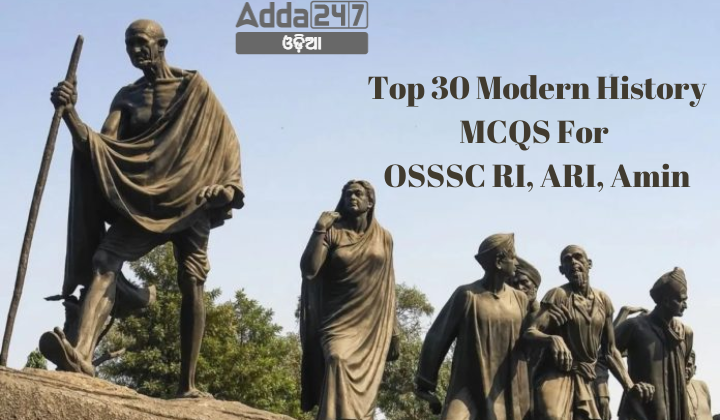Preparing for competitive exams such as OSSSC RI (Revenue Inspector), ARI (Assistant Revenue Inspector), Amin, SFS, or ICDS Supervisor often requires a strong grasp of historical events. Modern history, especially, forms a significant part of the syllabus, covering crucial periods and events that shaped the world as we know it today. To aid in your preparation, here are 30 multiple-choice questions (MCQs) focusing on modern history:
Top 30 Modern History MCQs for OSSSC RI,ARI, Amin, SFS, ICDS Supervisor
- Where was Chhatrapati Shivaji Maharaj born?
(a) Raigarh
(b) Satara
(c) Shivneri (Poona)
(d) Bijapur
Ans: (c) Shivneri (Poona) - In which year did Chhatrapati Shivaji Maharaj assume full charge of his jagir?
(a) 1640 CE
(b) 1647 CE
(c) 1650 CE
(d) 1657 CE
Ans: (b) 1647 CE - Who was the Maratha chief from whom Chhatrapati Shivaji Maharaj conquered Javli?
(a) Shahji Bhonsle
(b) Afzal Khan
(c) Chandra Rao More
(d) Shaista Khan
Ans: (c) Chandra Rao More - Which fort was captured by Maratha troops after the death of Afzal Khan?
(a) Purander
(b) Kondana
(c) Panhala
(d) Torna
Ans: (c) Panhala - Which Mughal governor did Chhatrapati Shivaji Maharaj carry out a daring night attack on in 1663 CE?
(a) Shaista Khan
(b) Raja Jai Singh
(c) Adil Shah
(d) Aurangzeb
Ans: (a) Shaista Khan - In which year did Chhatrapati Shivaji Maharaj first attack the Mughal port, Surat?
(a) 1659 CE
(b) 1664 CE
(c) 1667 CE
(d) 1670 CE
Ans: (b) 1664 CE - What was the result of the Treaty of Purander in 1665 CE?
(a) Chhatrapati Shivaji Maharaj surrendered all his forts to the Mughals
(b) Chhatrapati Shivaji Maharaj became an ally of the Bijapur Sultanate
(c) Chhatrapati Shivaji Maharaj retained 12 forts under Mughal service and loyalty
(d) Chhatrapati Shivaji Maharaj was imprisoned by Aurangzeb
Ans: (c) Chhatrapati Shivaji Maharaj retained 12 forts under Mughal service and loyalty - In which year did Chhatrapati Shivaji Maharaj crown himself and assume the title “Chhatrapati”?
(a) 1670 CE
(b) 1674 CE
(c) 1676 CE
(d) 1680 CE
Ans: (b) 1674 CE - Which regions did Chhatrapati Shivaji Maharaj capture during his expedition into the Carnatic in 1676 CE?
(a) Surat and Berar
(b) Ginjee and Vellore
(c) Purander and Khandesh
(d) Kolhapur and Satara
Ans: (b) Ginjee and Vellore - What major event occurred in Chhatrapati Shivaji Maharaj’s life in 1665 CE after visiting Agra?
(a) He was crowned as Chhatrapati
(b) He attacked Surat
(c) He was imprisoned by Aurangzeb but managed to escape
(d) He signed the Treaty of Purander
Ans: (c) He was imprisoned by Aurangzeb but managed to escape - Who was the Nawab of Bengal who opposed the British due to the misuse of dastaks and captured Fort William in 1756 CE?
(a) Alivardi Khan
(b) Mir Jafar
(c) Mir Qasim
(d) Siraj ud Daulah
Answer: (d) Siraj ud Daulah - What significant event occurred on 23rd June 1757 CE?
(a) The signing of the Treaty of Allahabad
(b) The Battle of Buxar
(c) The Battle of Plassey
(d) The capture of Fort William
Answer: (c) The Battle of Plassey - Who was the British commander who emerged victorious at the Battle of Plassey?
(a) Robert Clive
(b) Warren Hastings
(c) Sir John Clive
(d) George Monck
Answer: (a) Robert Clive - What was the main reason for the British victory in the Battle of Plassey?
(a) Superior military tactics
(b) Treachery of Mir Jafar
(c) High morale of British troops
(d) Advanced weaponry
Answer: (b) Treachery of Mir Jafar - What was the outcome of the Battle of Buxar for Mir Qasim?
(a) He was reinstated as Nawab of Bengal
(b) He was defeated and fled to Awadh
(c) He was captured and executed
(d) He successfully allied with the British
Answer: (b) He was defeated and fled to Awadh - On what date did the Battle of Buxar take place?
(a) 22nd October 1764
(b) 23rd June 1757
(c) 17th December 1764
(d) 1st January 1765
Answer: (a) 22nd October 1764 - What was the main administrative change introduced by Robert Clive in Bengal after the Battle of Buxar?
(a) The end of dual government
(b) Establishment of a new tax system
(c) Introduction of Dual Government
(d) Imposition of direct British rule
Answer: (c) Introduction of Dual Government - According to the Treaty of Allahabad, what was the status of Shuja-ud-Daulah and his state?
(a) He retained control of Awadh without any conditions
(b) He was replaced by a British nominee
(c) He had to pay Rs 50 Lakhs and maintain English troops
(d) He was granted a pension by the British
Answer: (c) He had to pay Rs 50 Lakhs and maintain English troops - What rights were granted to the English under the Treaty of Allahabad regarding Bengal, Bihar, and Orissa?
(a) Rights to administer the provinces directly
(b) Rights to collect revenue
(c) Rights to establish military bases
(d) Rights to trade without restrictions
Answer: (b) Rights to collect revenue - Who was the Mughal Emperor that granted the Diwani rights of Bengal, Bihar, and Orissa to the English?
(a) Shah Alam II
(b) Aurangzeb
(c) Farrukhsiyar
(d) Akbar
Answer: (a) Shah Alam II - Who administered Bengal in place of Mir Jafar during the Battle of Buxar?
(a) Shuja-Ud-Daulah
(b) Shah Alam II
(c) Mir Qasim
(d) Robert Clive
Answer: (c) Mir Qasim
Explanation: Mir Qasim was the Nawab of Bengal who replaced Mir Jafar. He was discontent with the misuse of dastak and farmans by the English and sought to challenge their authority. - Which ruler formed a confederacy with Mir Qasim and Shah Alam II?
(a) Mir Jafar
(b) Shuja-Ud-Daulah
(c) Robert Clive
(d) Hector Munro
Answer: (b) Shuja-Ud-Daulah
Explanation: Shuja-Ud-Daulah, the Nawab of Awadh, joined forces with Mir Qasim and Shah Alam II in an attempt to drive the British out of Bengal. - Who led the English forces in the Battle of Buxar?
(a) Robert Clive
(b) Hector Munro
(c) Mir Jafar
(d) Mir Qasim
Answer: (b) Hector Munro
Explanation: Hector Munro was the British Army Major who commanded the English forces during the Battle of Buxar. - What was the outcome of the Battle of Buxar on October 22, 1764?
(a) The English forces were defeated.
(b) Mir Qasim was victorious.
(c) The English forces won the battle.
(d) The battle ended in a stalemate.
Answer: (c) The English forces won the battle.
Explanation: The English, under Major Hector Munro, emerged victorious in the Battle of Buxar, leading to significant changes in the control of Bengal. - Which treaty concluded the Battle of Buxar?
(a) Treaty of Paris
(b) Treaty of Allahabad
(c) Treaty of Versailles
(d) Treaty of Delhi
Answer: (b) Treaty of Allahabad
Explanation: The Treaty of Allahabad was signed in 1765, marking the end of the conflict and outlining the terms of settlement between the English and the defeated rulers. - What were the key terms of the Treaty of Allahabad between Robert Clive and Shuja-Ud-Daulah?
(a) Shuja-Ud-Daulah had to surrender Midnapore and Chittagong.
(b) Shuja-Ud-Daulah had to pay Rs 50 lakh as war indemnity.
(c) Shuja-Ud-Daulah was granted the Diwani of Bengal.
(d) Shuja-Ud-Daulah had to cede Delhi to the British.
Answer: (b) Shuja-Ud-Daulah had to pay Rs 50 lakh as war indemnity.
Explanation: As part of the treaty terms, Shuja-Ud-Daulah was required to pay a substantial indemnity to the British and surrender Allahabad and Kara to Shah Alam II. - According to the Treaty of Allahabad, what was Shah Alam II required to do?
(a) Cede Bengal to Shuja-Ud-Daulah.
(b) Reside at Allahabad and issue a Farman granting the Diwani of Bengal, Bihar, and Orissa to the East India Company.
(c) Pay Rs 50 lakh to the Nawab of Awadh.
(d) Hand over Delhi to the English.
Answer: (b) Reside at Allahabad and issue a Farman granting the Diwani of Bengal, Bihar, and Orissa to the East India Company.
Explanation: Shah Alam II was required to live in Allahabad and issue a Farman that granted the British East India Company control over Bengal, Bihar, and Orissa in exchange for an annual payment. - What was the fate of Mir Jafar after the Battle of Buxar?
(a) He was reinstated as Nawab of Bengal.
(b) He was removed from power and his minor son was appointed Nawab.
(c) He was captured and executed.
(d) He was exiled to England.
Answer: (b) He was removed from power and his minor son was appointed Nawab.
Explanation: After the battle, Mir Jafar was removed from his position, and his minor son, Najimud-Daula, was appointed as Nawab of Bengal, though real power remained with the English. - What was the significance of the Battle of Buxar for the English East India Company?
(a) It marked the end of British influence in India.
(b) It consolidated British control over northern India.
(c) It led to the decline of British military power.
(d) It resulted in the withdrawal of British forces from India.
Answer: (b) It consolidated British control over northern India.
Explanation: The victory at the Battle of Buxar solidified the East India Company’s dominance in northern India and paved the way for greater control over the region. - Which of the following was NOT a term of the Treaty of Allahabad?
(a) Shuja-Ud-Daulah had to surrender Allahabad and Kara.
(b) Shah Alam II was to be granted the Diwani of Bengal, Bihar, and Orissa.
(c) The English were allowed duty-free trade in Bengal.
(d) The English were required to pay Rs 53 lakh for Nizamat functions.
Answer: (c) The English were allowed duty-free trade in Bengal.
Explanation: While the English were allowed trade in Bengal with a minor duty on salt, the treaty did not grant them complete duty-free trade.










